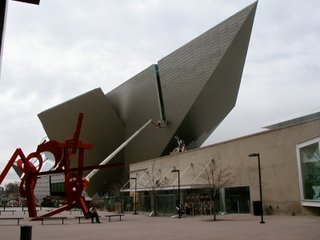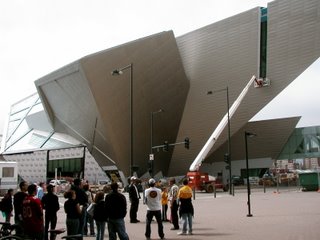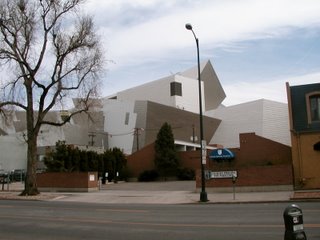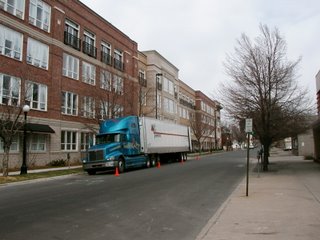Goodbye to All That...
No, I'm not saying goodbye to this blog. The title refers to illusions that are finally shattered. Read on (and if you get to the bottom, thanks--this is a long one).
I just finished reading a trio of books that have got me thinking (uh oh). Readers--those marvelous few of you--may remember my obsession last summer with a book by James Howard Kuntsler, The Long Emergency. In it, the WASP Kuntsler predicts the next fifty years of American history--not literal predictions, such as on March 1, 2027 Jenna Bush will be appointed Queen--but rather more general ones, such as: we're all going to freeze in the dark, and we won't have any water to drink (at least not out here in the West) because Colorado will become a lot more like El Paso due to global warming. And you faithful readers will remember that Kuntsler "had me," until I got to the xenophobic part: his surety that Mexicans will destroy American culture. After I read that bit, near the end of his book, I was forced to take another look at the entire work, and over several weeks and months I came to decide that he was too negative--that he had discounted human ingenuity too much, and had taken the opportunity at every turn to imagine the absolute worst case scenario. He fear-mongers, in other words--just like the GOP and Fox News (who have this week merged--that's Jon Stewart's joke, not mine).
This was, of course, a great disillusionment for me. I had loved his three earlier works on urbanism: The Geography of Nowhere, Home From Nowhere, and I can't remember the third--although now that I think of it, there were seeds of xenophobia even in that third book on urbanism. He explored several past and present cities in that book, including Tenochtitlan--modern Mexico City. The theme of that chapter was human sacrifice, and it's quite a grisly read.
But back to this trio. First, because there's a play opening soon (or maybe it's already open) in New York based on Ray Bradbury's Fahrenheit 451. The article I'd read in the Times made me want to read this most essential of sci-fi works, and good lord--what a book! Published in 1952 or 1953, Bradbury describes in this five-decade old work an America that is much like what we see today--or rather, the America we have now is much closer to the America depicted in 451 than any reader in the 1950s could have imagined. The society of 451 is made up of people completely devoid of empathy. Entertainment consists of watching (on a kind of 3-D television, coverering three out of four walls in a room) the authorities track down the book's hero after he has begun rebelling against the way things are (he's a fireman, whose job description it is to burn books--paper combusts at 451 F). How different is that, really, from Cops or Dog The Bounty Hunter? Do you feel empathy for the idiots they put behind bars on those shows, or do you sit there feeling superior? I know I do--because, although I don't lack empathy entirely, I do lack enough that I find those shows fun to watch when I just want mind candy.
Then I read a recent (perhaps still current) bestseller, Thomas L. Friedman's The World is Flat. Most people know Friedman from his syndicated Times column, and from his previous bestsellers like The Lexus and the Olive Tree. In this book, Friedman goes around the world in an effort to get an understanding of globalism. He loves globalism, of course--he's famous for his love for it. And the globalism that Friedman portrays looks like a pretty good system--because he mostly focuses on the changes happening to India, which is in the midst of a high-tech boom that is improving the lives of many, many Indians. Friedman's India is a place where the Muslims don't hate the west--because India's government, since its founding in the 1940s, has emphasized education--and this has paid off. He talks about Wal-Mart, he talks about Starbucks, and he rightly worries about the Bush "administration"'s hatred of facts and of science. He describes an America that is losing its edge while its citizens drive their kids to soccer practice and its leaders do nothing to shift the direction of the country back in a positive direction.
But ultimately, The World is Flat rings a little hollow for me. While I agree with Friedman that we desperately need to stop resting on our laurels, and also stop trying to change the world to fit our ideal picture through force of arms, I think he's been seduced by the speed of the changes that are happening. He's a reporter, and so he loves things that change and move--that provide a story. But he's no economist (as he admits), and he's certainly no historian. People who know me know my opinion of the state of American journalism--I was a history major in college, and every time a journalist tries his or her hand at history, the results are usually so off-base that they prove harmful. Boy, do I sound like a snob, or what?
Then I picked up Dark Ages America, by Morris Berman. Go to the Tattered Cover immediately and buy a copy:
 http://www.tatteredcover.com/NASApp/store/Search;jsessionid=aMD382snRTSh
http://www.tatteredcover.com/NASApp/store/Search;jsessionid=aMD382snRTSh
I've already loaned my copy to Ron-n-Ellen, so I can't quote directly--which is a shame, since Berman is a marvelous writer, who doesn't waste a word, and delves so deeply into each point that the book is peppered with "a-ha!" moments--ideas that make you amazed that someone out there has been thinking the same thoughts as you.
Berman's central thesis: we're fucked, and there's nothing we can do about it. But he's not like Kuntsler, who says we're all going to freeze in the dark because of our SUV and McMansion addictions (although Berman is no fan of SUVs and McMansions). For Berman, the point is that our American civilization has reached a twilight phase, and is bound to decline. All civilizations decline. Ours is like late Rome--which, besides not being built in a day, didn't fall in a day either (although of course modern technology provides the means to do just that, something the Huns and Avars and Visigoths and Ostrogoths never dreamed about).
America is, in Berman's view, essentially an invalid. We've hollowed out our industries--how much bigger now is Airbus than Boeing? Look at money-bleeding GM and Ford. We've gone from being responsible for 50% of the world's industrial output in 1945 to being a country that imports nearly everything. Friedman would say that's not a bad thing--outsourcing basic things like shoe production or the writing of software code (as opposed to the design of actual programs, which largely is still an American function) provides opportunities for American companies to invest the savings into new things that workers here can do. Except, of course, that's not what happens. The money saved goes to the shareholders, and to the CEOs.
Berman sees an American economy that runs for one major reason only: that foreign countries are currently willing to fund our excessive consumption. I'm typing this on a MacBook Pro that came from Shanghai (I tracked it on FedEx back in February), and I bought it using my Citi MasterCard (I've already paid down most of the cost of the computer, but I still have other debt). I may think that Citicorp is an American institution--it is, I suppose, legally one--but the reality is that Citi funds my debt with money they get from the Chinese, or from the Europeans, or from the Saudis. Who knows, actually, whence the money derives? The foreigners do this because America has been, for more than a century, the largest economy in the world, and everyone has wanted to business with us. But they won't much longer--our consumption (and war, as currently practiced as the primary instrument of our foreign policy, is a form of consumption too) is completely out of hand, and the well will run dry. It has to, because we are a net importer of capital, as well as being a net importer of oil and consumer goods.
I mention my relatively new computer because it points to the other central thesis of Berman's book: that (to probably mangle the famous Pogo quotation) we have seen the enemy, and he is us. This gets back to Bradbury: we, as a nation, have lost our ability to empathize with our fellow human beings. It's not just that we don't empathize with the relatives of Muslims killed by our wars 10,000 miles away--or that Abu Ghraib caused so little outrage, except amongst us few liberals who are paying some attention--or that Americans are being tortured every day in our massive criminal justice system, but no one worries about the incarerated, because somehow they're not like us. No, it's that we enter an alien world--of our own creation--every time we leave our home. We sort-of empathized with the Katrina victims, and the relatives of people killed on September 11th. But did we really? Berman would say no, and I think he's right. Any empathy people might have claimed they had for the Americans who died in the WTC, or the (mostly Black) Americans who lost their little wooden shacks in the lower 9th Ward last summer was a sort of false empathy--people might have done something to help, but if they gave a donation they made sure they got a receipt, so they could claim it on their 1040.
And giving a donation is all most people did--that's all I did. It was easy as pie to add $20 to a purchase at Costco. The Red Cross has figured out if it wants money, it has to get in with the retailers, you see, because retail is our religion (yes, even, and perhaps especially so, for the true believing Fundamentalist Christians). If we're going to feel guilt (not empathy, just good old guilt, like religious people used to feel when they sinned) for the $150 we're spending on stuff we don't need, putting up a barcode up at a register, so all that the cashier has to do is scan it like any other product, and ask you how much you want to contribute, is a sure fire way to raise money.
But back to the alien world: do you rush to beat that other person to the front door of the restaurant, so you can get in there first, and be seated and get your drinks before they do? Do you flip the bird at someone who cut you off, screaming "You stupid FUCK!" at the top of your lungs? What about that lady who was trampled at Wal-Mart the day after Thanksgiving a few years ago, because everyone was trying to get a $79 DVD player at five o'clock in the morning--because every W-M only had ten, and if you waited until 5:05 they'd be gone? (Berman points out that this particular case is complicated by the fact that the women who was trampled was a former employee who had been pulling similar stunts already--but the point was: no one in that crowd tried to help her, stunt or no). We are the aliens, and our ancestors wouldn't want to know us.
People in other countries--at least, other Western countries with the European Enlightenment as part of their cultural heritage, as it is part of ours--aren't like this. We're assholes. Berman talks about the sequence in Bowling for Columbine where Michael Moore explores the question: why don't Canadians kill each other the same way we do? They have easy access to guns--but they don't have anywhere near the same murder rate. Then there's our love of the death penalty--people here never think about it (or at least, the vast majority don't, otherwise they'd actually have to understand the moral problem of the state taking a life). Criminals get what they deserve, that's what Americans say. Criminals aren't people.
Berman also says we're probably too far gone down the path of decline to rescusitate our society. He points to the fact that we've been an imperial power--denying the whole time that we're not--for more than a century. In all of that time, there was only one US president who tried to change things, to make our foreign policy non-imperialistic. His name was Jimmy Carter, and look what happened to him when he dared speak the horrible truth about our society: JC was crucified. The Ray-gun Revolution swept away our brief moment of self-questioning, and it was Morning in America again (except that it was actually quarter of five on a December afternoon after Christmas). (Another book worth reading: Our Endangered Values, the most recent work by our 39th President).
Many commentators (and Berman isn't one of them, really--he uses other, less trite, metaphors) have said that we're a nation of juveniles. The idea, despite its overuse, rings true. Look at that mumbling buffoon in the White House--he's not qualified for a high school debate team. And that other guy, the one with the rifle--there's a great piece in the current American Prospect about how his staff are so adamant on having their way in every discussion that if it's not going their way they leave the room rather than listen to conflicting opinions. Then there's that big baby over at the Pentagon, who excuded Abu Ghraib as young people letting off steam (except that he ordered their crimes). But I slip off subject here a bit....
Groupthink has taken over. We have destroyed our legitimacy in the eyes of the other 95% of the world--Mexicans may still want to come here, but only because it's close and things are worse if they stay there. China is growing like a weed (Berman spends some time pointing out that the Chinese are no better than Americans in their addiction to consumerist values, and also that they lack that marvelous Enlightenment tradition that allows writers like him to say what he thinks, at least for now, in this country). India is as Friedman portrays it--also growing like a weed. Europe--its achilles heel being its rapidly aging population and related need to import foreigners to perform essential functions--is 450 million strong, doesn't feel the need to be the world's policeman, and is home to most of the world's largest banks. Japan has largely bounced back from its decade-long post-Bubble slump.
And then there's the theory I came across somewhere a couple of months ago that the real reason for the Iraq War was none that have been discussed among liberals or conservatives. The theory holds that it was Saddam's threat to stop accepting the American Dollar as payment for oil that caused the US to feel the need to destroy his regime. It's that old domino theory (and Berman talks about the modern "terrorism domino theory" as a substitute for the old Cold War communism domino theory, the supposed reason for Korea and Viet Nam--but that's another discussion)--that once one large oil producer switches to the Euro for oil, the Dollar is toast. Except that it's not a theory--it's a real threat to our economy. So if that was the Bushies' real reason for invading Iraq, so be it--but wouldn't it have been nice if they had been honest with the American public?
The thing is: honesty is something we can never again expect from Presidents (except the aging 39th)(although, when you come to think about it, even the "good" ones lied). Berman explores the question of whether a Kerry victory would have been any better for America (he makes no real mention of the stolen votes in Ohio--Kerry actually won, but it's un-provable, because the GOP did a better job of forcing things through than they did in 2000). In certain respects, yes--we wouldn't be bungling the Iran nuke mess the way we are now, and maybe we wouldn't be extending the tax cuts for the wealthiest 1%, etc. But in the main, no: Kerry, like WJ Clinton before him, would have been forced--despite whatever shred of Boomer idealism he had left in him--to accept the imperial project begun by the McKinley generation so many decades ago.
Ah, you're tired of reading at this point. I need to stop typing, because I'm getting a crick in my neck. Just go out and find a copy of Dark Ages America. Read it, and then think about what you can do to at least stem the tide of our decline just a little bit. Better yet, don't think, Just Do It!
This posting sponsored by Nike.







